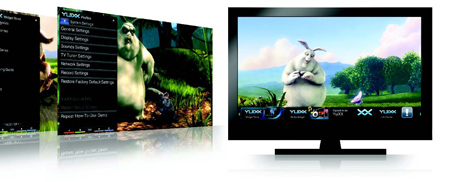Managing Trigger-Happy Digital Content

A Harris Dynacast-infused system allows operators to sell ads on Web pages synchronized to specific programs.
LOS ANGELES
Managing digital content has its obvious rewards: streamlining production, managing archives, repurposing assets, just to name a few. But in the future there may also be an added revenue bonus if multiplatform assets can be connected to automatically trigger audience response.
A broadcast program's on-air signal with an embedded connection to an Internet trigger could enable users to instantly get more background or related information about a news/weather item, sports preview, awards event, or sponsor's product. Moreover, DTV users could take this all in as they pause the broadcastóand text or e-mail a query to the broadcaster or FYI to a friendóthen go back for more of the programming.
"TV can trigger new things that automatically pop up on the Web site," said Gerry Kaufhold, principal analyst with media research firm In-Stat. "As soon as you start to have the mobile on-air signal on handheld [receivers] later this year, you've got the possibility to do even more interesting things."
This scenario could prolong audience engagement by opening up multiple points of contact between consumers and the broadcaster. The prospect would have positive implications for courting advertisers, who have already begun to doubt the efficacy of traditional TV ad models.
DYNACAST
Introduced in 2008, Harris Corp.'s Dynacast interactive Internet broadcasting solution enable broadcasters to automatically deliver Web URLs directly related to their programming to viewers, without the need for third-party distribution agreements. Moreover, audiences can access the synchronized Web content during the scheduled airing of the show or during playback from a personal video recorder, VOD server, or DVD.
The Web-based communications software solution was powered by technology first developed by Desktopbox, a Toronto-based pioneer in multiplatform synchronization, whose assets were formally acquired by Harris in April 2008. This technology was integrated into Harris' H-Class content delivery platform, broadcast automation products. Vision scheduling system, and traffic and billing systems.
A Harris Dynacast-infused system allows operators to sell ads on Web pages synchronized to specific programs; expand brand recognition by cross promoting products on the air and on the Web; create product placement opportunities by exposing Web pages for products featured in programs; enhance the viewing experience by supplementing existing programming with related Web pages; achieve higher viewer retention, with a resulting increase in spot rates and increase traffic to a station's Web site, according to the company.
"Dynacast is the engine that will drive the integration of Web content and TV into Internet-ready televisions," said Michael Davenport, Harris product manager, in a Web blog.
In fact, the evolution of the two-screen model into an integrated and synchronized multiplatform-enabled television set is already unfolding.
FROM TWO SCREENS TO ONE
At the 2010 International CES in Las Vegas, Intel introduced the YuiXX "next generation Internet media player," which the company said "combines personal content with protected third-party content and services."
Marketed under the brand name Conceptronic, YuiXX is produced by 2L Alliance, a Dutch-based provider of networking, media and connectivity products, in conjunction with two other Dutch companies: manufacturer ProDrive and total integrator Metrological Media Innovations. YuiXX also uses Intel's Media Processor CE 3100, a new SOC that enables the YuiXX to multi-task different kinds of media for the new, fuller entertainment experience.

At the 2010 International CES in Las Vegas, Intel introduced the YuiXX “next generation Internet media player.” Its unique Widget Channel Technology, which brings Internet applications ("widgets") to CE devices, lets users tap into the YuiXX widget store with two clicks of a remote control for a menu of options to incorporate into their personal viewing experience. For example, the Media Widget can store and organize personal videos, music and photos onto the TV set, where it can also be accessed by computers in the home. Other widgets provide video on demand, news, traffic or weather information, and games.
The first units were scheduled to be available in stores in the Netherlands at the end of January for a suggested retail price of $414, or $552 with a 1 TB internal hard disk. According to the manufacturer, the YuiXX can "choose among different tuner types for multiple countries and [is] compatible with ISPs, telcos or cable companies."
Elsewhere a European initiative called "Hybrid Broadcast Broadband TV" (HbbTV) has developed a specification to better meld the delivery of broadcast and broadband content. Last December, representatives from more than 20 companies (broadcasters, software providers and consumer electronics device manufacturers) gathered in Munich to evaluate HbbTV applications and implementations.
REVENUES FROM SYNCHRONICITY
Combining a Dynacast-like application and TV widget concept would deliver a TV experience in which consumers can "zap" for more background information by using a remote control device, said John Goedegebuure, an ITV adviser to both Harris Corp. and Metrological Media Innovations.
It would also provide new revenue streams for broadcasters, particularly via the one-screen option.
A Multi Layer TV Advertising (MTLA) approach would allow consumers to "pull information" via clicks rather than have TV commercials "slammed" in their face, according to Goedegebuure. What's more, he said, content could be better leveraged with advertisers for additional revenue streams.
"Traditional linear TV commercials limit advertisers to time slots, whereas MLTA can be implemented in each and every TV program," he said.
Moreover, he believed MLTA could be implemented through a variety of opt-in implementations: marketing opportunities beyond actual sales to trends in consumer behavior in general, and program-related social networks in particular.
"Advertisers have to justify the amount of capital invested in publicityówhether or not they are reaching the right target groups," said Goedegebuure. "It is crucial that broadcasters and TV service providers rapidly identify and implement new and effective advertising models."
The professional video industry's #1 source for news, trends and product and tech information. Sign up below.
